|
|
|||
|
(Back to Preceding Week; on to Next Week) |
|
|
|
NO HUMMINGBIRDS?
Without ever referring to a calendar at Hilton Pond Center we'll always know when late June arrives because we start getting lots of phone calls and e-mails from folks across the country with the same question: "Where are my hummingbirds?" This year is no exception. Dozens of people have told us they had lots of Ruby-throated Hummingbirds in 2008 and few to none in 2009 (lonely feeder, above), but after we question they typically reveal their backyard feeders actually were busy in August and September when hummingbirds were at peak numbers due to fledging of that year's broods. Other callers say they had several hummingbirds in April and May but all or most of them disappeared, to which we respond this is a "normal" occurrence, probably due to three factors: 1) In most parts of the U.S. many early hummers are migrants moving through, so they can be at a feeding station one day and gone the next; 2) After an initial flurry of feeder activity, female ruby-throats hunker down on their nests and show up at feeders much less frequently; and, 3) Adult males (below), originally intent on territorial defense and copulating with as many females as possible, take a breather and spend lots of time just sitting quietly on some distant perch. (A fourth factor is that your neighbors may be "stealing" your birds by providing better hummingbird habitat and by being more conscientious in maintaining their sugar water feeders. Hint, hint.)
All text, tables, charts & photos © Hilton Pond Center By late June two other major factors may influence feeder visitation by hummingbirds: Nectar-rich native (and ornamental) plants are in bloom and insects abound, meaning hummers can get carbs, fats, and proteins they need from "natural" sources. With all this in mind, we simply advise our correspondents to remain diligent in keeping feeders clean and fresh all summer, knowing their hummingbird numbers are likely to increase almost exponentially come August. That said, we have to admit the hummingbird situation at Hilton Pond Center isn't looking very good so far in 2009; in fact, it's the worst we've ever experienced by this point in the banding season.
All text, tables, charts & photos © Hilton Pond Center As of 30 June, we still have banded only TWO new Ruby-throated Hummingbirds--both adult males. This is an astoundingly low number when compared with an average of 24 RTHU banded by that date during the past 19 complete field seasons at Hilton Pond (see column 2, Table 1 above). That means this year we've banded only 8.3% of the number of RTHU expected by 30 June. Curiously, our second-lowest April/May/June totals occurred LAST year with just seven hummers banded during that period, and 2008 ended up being our BEST year ever with 230 ruby-throats--even though we had banded only 3% of those 230 birds by 30 June 2008. If we extrapolate and say, on average, we capture 14% of a given year's totals by the end of June, we'll only band 14 RTHU in 2009, and we're pretty confident there's no way that will happen. All text, tables, charts & photos © Hilton Pond Center (Click on image above for a larger version in a new browser window) What becomes more obvious with every year we band Ruby-throated Hummingbirds is that the number of hummers present at Hilton Pond Center in spring is NOT an indicator of how many we'll have in mid-summer or fall, nor of how many we'll end up banding for the entire field season. As the chart above shows, 2009 (red line) has indeed started VERY slowly, with only two RTHU banded through 30 June. By comparison, 2008 (dark pink line) was also very slow--seven birds banded through that date--but things began to improve in early July and continued escalating through early October to last year's record-setting high of 230. Like all things in nature, populations of Ruby-throated Hummingbirds are somewhat cyclic. Various environmental factors have impact on migration success, winter survival, and reproductivity--all of which determine how many hummers you see at your feeders in any given year. Weather also affects how prolifically nectar plants bloom and how plentiful tiny insects might be, and these factors in turn influence viability of adult and nestling ruby-throats. To complicate matters further, happenings in your neck of the woods may be entirely different from what's occurring just a few miles down the road at a locale in which RTHU breed or through which they migrate; thus, it's difficult and maybe impossible to draw comparisons across the huge area of eastern North America in which Ruby-throated Hummingbirds occur March through October.
The Bottom Line: After 25 years of scientific study at Hilton Pond Center, we've given up predicting how many RTHU we'll band based on how many we capture each spring. Thus, our advice to hummer enthusiasts is that you not fret if you don't have any or many Ruby-throated Hummingbirds by the end of June. Instead, keep your feeders fresh and install numerous native nectar plants. Do this and hummers--especially juvenile males (above)--very likely will begin appearing in coming weeks and reach rewarding numbers by the time September rolls around. Just wait. All text, tables, charts & photos © Hilton Pond Center
Comments or questions about this week's installment?
Thanks to the following fine folks for recent gifts in support of Hilton Pond Center for Piedmont Natural History and/or Operation RubyThroat: The Hummingbird Project. Your tax-deductible contributions allow us to continue writing, photographing, and sharing "This Week at Hilton Pond." (Please see Support if you'd like to make a gift of your own. You can also contribute by ordering an Operation RubyThroat T-shirt.)
"This Week at Hilton Pond" is written & photographed You may wish to consult our Index of all nature topics covered since February 2000. You can also use our on-line Hilton Pond Search Engine at the bottom of this page. For a free, non-fattening, on-line subscription to |
|
Make direct donations on-line via
Network for Good: |
|
|
Use your PayPal account
to make direct donations: |
|
|
If you like to shop on-line, you please become a member of iGive, through which more than 750 on-line stores from Barnes & Noble to Lands' End will donate a percentage of your purchase price in support of Hilton Pond Center and Operation RubyThroat. For every new member who signs up and makes an on-line purchase iGive will donate an ADDITIONAL $5 to the Center. Please sign up by going to the iGive Web site; more than 200 members have signed up to help. It's a painless, important way for YOU to support our on-going work in conservation, education, and research. |
|
|
SPECIES BANDED THIS WEEK: * = New species for 2009 WEEKLY BANDING TOTAL 8 species 24 individuals YEARLY BANDING TOTAL (2009) 34 species 1,076 individuals 28-YEAR BANDING GRAND TOTAL (since 28 June 1982, during which time 170 species have been observed on or over the property) 124 species 52,958 individuals
|
OTHER NATURE NOTES OF INTEREST --Katydids finally got cranked up this week at Hilton Pond Center, punctuating the otherwise quiet midsummer night with their incessant, repetitive calls. --Updated banding totals for the past 28 years at the Center are available by clicking on the image above.
|
|
|
|
(Back to Preceding Week; on to Next Week) Up to Top of Page Back to This Week at Hilton Pond Center Current Weather Conditions at Hilton Pond Center |
 You can also post questions for The Piedmont Naturalist |
Join the |
Search Engine for |
|
|
fitness programs


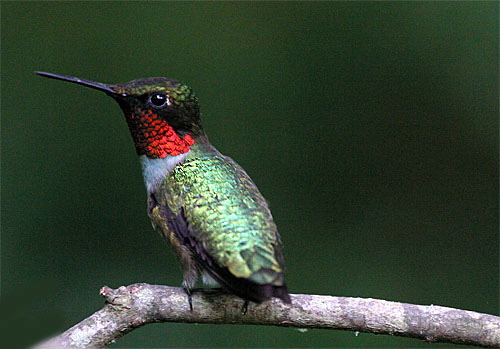
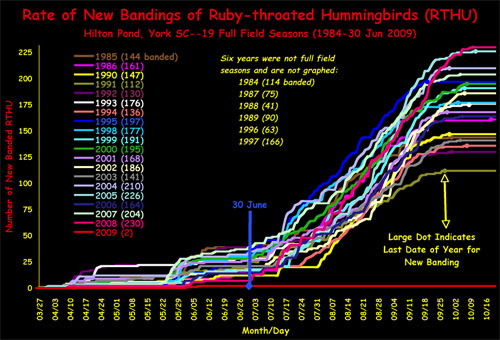
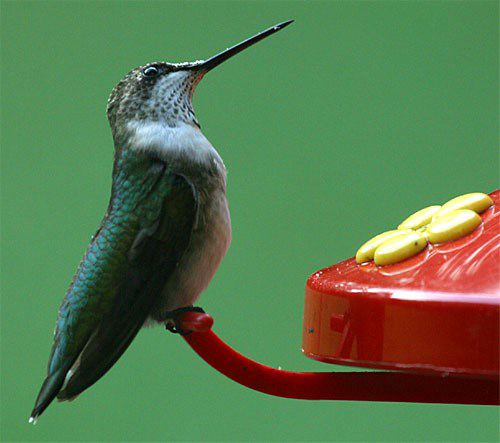
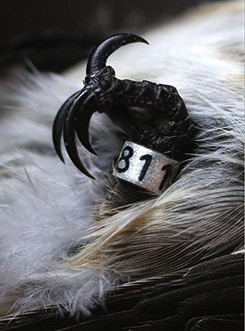 ADDENDUM: For the record, through 30 June we've had returns of only three Ruby-throated Hummingbirds captured in previous years at Hilton Pond Center: A second-year male banded as a juvenile last year; an after-second year female banded in 2008 as an adult; and a fourth-year female banded as a young bird in 2006. Our 19-year complete-season average for returns through 30 June is 18, so in 2009 we are far behind in this category just as we are with new captures. By comparison, in 2007 we had a whopping 43 returns by the end of June and ended with a record high of 49.
ADDENDUM: For the record, through 30 June we've had returns of only three Ruby-throated Hummingbirds captured in previous years at Hilton Pond Center: A second-year male banded as a juvenile last year; an after-second year female banded in 2008 as an adult; and a fourth-year female banded as a young bird in 2006. Our 19-year complete-season average for returns through 30 June is 18, so in 2009 we are far behind in this category just as we are with new captures. By comparison, in 2007 we had a whopping 43 returns by the end of June and ended with a record high of 49.

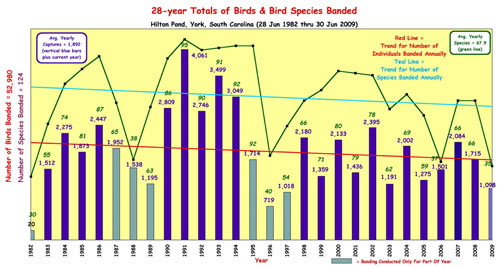

 Please report your
Please report your